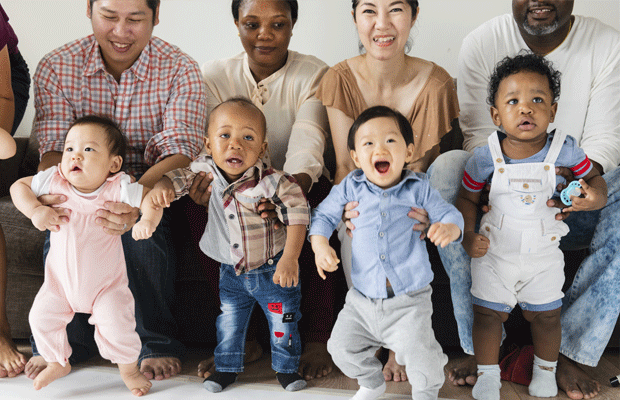A certain amount of anxious focus on a child occurs in all families. It is in the nature of the human offspring to need quite a lot of care for quite a long time. Whether that care is in tune with the actual needs of the child as those needs change over the course of growing up, or is governed more by the emotional needs of the parents, is the key question. The degree of intensity of the attachment between mother and child, within the mother-father-child triangle, is key to the degree to which the child develops a mature self.
Projection of immaturity to a child varies in intensity between different families, and between children in the same family. It operates with greatest intensity in families in which it is the main avenue for absorbing tension and less intensity in families that employ the other patterns of distance, marital conflict and dysfunction in a spouse. Bowen used the biological term, symbiosis, to describe the mother-infant attachment. In this eloquent passage, he captures the essence of the symbiotic process:
The main threat to the continuation of the mother-child symbiosis is the growth process in the child. Described as a phenomenon, the symbiosis attempts to make two lives stand still at a particular pleasurable phase in both life cycles. In the beginning, the mother-infant symbiosis is a normal stage in the course of a life from birth to death. When it is perpetuated, it becomes a foreign thing, threatened by the biological progression of the very life process of which it was once a part. (Bowen, Family Therapy in Clinical Practice, 1978, 64.)
Bowen described the mother and child as “being for the other,” the child being helpless for the mother, the mother being strong for the child, the father supporting the mother. “Even though both parents have a conscious wish for the child to grow and develop normally, they both automatically do things to keep the child in the helpless position (Family Therapy in Clinical Practice, 1978, 63.).” The parents’ relationship is calmer with this process, but the child is left with a dilemma: the impetus for growth and autonomy competes with the emotional pull to hold on to the dependent attachment. Michael Kerr notes that the child is not a scapegoat, but a participant in sustaining the intensity of the triangle with parents. “The parents are child-focused and the child has learned to be parent focused.” (Bowen Theory’s Secrets: Revealing the Hidden Life of Families, 2019, 38.)
In a variation of the projection process, a parent-focused child may become precociously competent, astute in sensing the needs and moods of parents, discovering ways of comforting and calming. Parents can miss seeing this child as a child and come to depend on her as if she were an adult. “What would I do without you?” is a potent question for a child to hear from a parent. A child may become important to a parent as a pseudo-partner, meeting needs that are more appropriately met in the marriage or other adult relationships. High levels of competence and achievement may rest on heightened sensitivity to parental expectations and emotional dependence on approval. The child becomes a source of more than ordinary pride and gratification for the parents and the wider family. The intensity of involvement in the parental triangle may be as great as with an impaired child even though it manifests as overfunctioning.
The family projection process that begins in the parental triangle moves organically through the larger family, engaging siblings and the extended family. Being the object of worried attention increases anxiety for the child. Greater anxiety in the child results in poorer functioning that in turn amplifies the anxiety-driving attention from adults, setting in motion a reciprocal process that intensifies focus on the child. Outside helpers in the school, community and health systems may become involved. Each person enlisted in the expanding network of triangles has the potential to add more anxiety or to lower it. While the intention of those involved is to be helpful to the child, the impact of the combined focus is increased anxiety and impairment in the child. It may set the child in a lifelong position of being regarded in the family as inadequate, a view often cemented with a medical diagnosis.
The projection process that Bowen originally observed and described in the family has application to all human systems. With increasing stress and tension, groups look for the source of the “problem”. Cause-and-effect thinking easily leads to identifying one person or one part of the system as the problem. No one is immune to becoming the focus of anxious attention from others. Laurie L. Lassiter describes the experience of being in the focus position: “The triangle, as a two-or-more-against-one process, is the bottom line of emotional pressure.” (“The Regulatory Function of the Triangle,” in Triangles, edited by Titelman, 2008, 64.) It is one thing to stand one’s ground with one person, but it becomes “a different level of challenge” when that person is joined by one or many others.
Dr. Bowen saw the projection process in society as a large-scale version of that in the family. The collective anxiety of a society is focused on targeted groups. Bowen identified a variety of such vulnerable groups, and noted that they become objects either for overly harsh and punitive treatment, or overly lenient and sympathetic treatment. The end result for those on the receiving end of the powerful projection process, whether the harsh side or the benevolent side, is that they are put into a “ ‘one down’ inferior position.” (Bowen, Family Therapy in Clinical Practice, Bowen, 445.)

